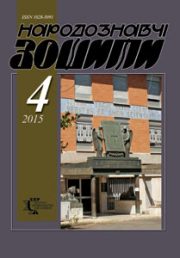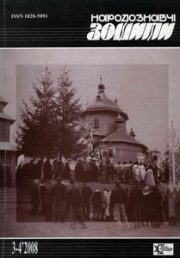The Ethnology Notebooks. 2024. № 3 (177), 617—630
UDK 746.5.011.26.045.02.03(477.83/.86=161.2)”19″:930.2
DOI https://doi.org/10.15407/nz2024.03.617
THE BEADED COTILLION AS AN ACTUAL ARTIFACT OF UKRAINIAN CULTURE: GENESIS AND PECULIARITIES OF USE
FEDORCHUK Olena
- ORCID ID: https://orcid.org/0000-0002-4724-3566
- Doctor of History (Dr. Sci.), Leading Researcher,
- The Ethnology Institute of the National Academy of Sciences of Ukraine,
- Historical Ethnology Department,
- 15, Svobody Avenue, 79000, Lviv, Ukraine,
- Contacts: e-mail: olena-fedorchuk@ukr.net
Abstract. The research is devoted to the beaded adornment, best known among Ukrainians as «cotillion». The adornment became widespread in Eastern Galicia and Bukovyna in the early XX century on the wave of national revival and the unfolding of the liberation struggle for Ukraine’s state independence. The adornment often contained Ukrainian folk symbols, making it a popular emblem of national identity.
The relevance of the article is due to the growing public interest in the studied adornment. Since the beginning of the Russian military aggression against Ukraine, the cotillion has attracted the attention of many Ukrainian artists who have begun to actively replicate it.
The information and illustrations collected in this article will contribute to the understanding of a little-known ethnic phenomenon of cotillion and the development of related contemporary artistic practices.
The object of the study is the ethnic artistic tradition of beaded decoration of Ukrainian folk costume, and the subject of the study is the genesis and peculiarities of the cotillion.
The scientific novelty of the work is a comprehensive analysis of the vast collection of information about the cotillion as an actual artifact of Ukrainian culture.
The research methodology is based on a systematic historical approach and such methods as historiographical research, interviews, photographic documentation of artifacts, audio recording of narratives, scientific analysis, analytical interpretation of the results, and historical reconstruction.
The source base of the study consists of the author’s field materials collected over twenty years, namely visual and verbal information about the beaded cotillion.
Cotillions from state museums, common photos from the first half of the XX century, and digital replicas of cotillions from academic colleagues and private collectors were all examined throughout the writing of this study.
Keywords: Ukraine, folk art, beaded jewelry, cotillion, national symbols.
Received 29.04.2024
REFERENCES
- Kurochkin, O. (1994). Ritualism (calendar holidays and ceremonies). In: Podillia: Historical and ethnographic research (Pp. 358—385).Kyiv: Dolia [in Ukrainian].
- Sakhro, M. (1987). Adornments from beads. In: Hutsul region: historical and ethnographic study (Pp. 440—442). Kyiv: Naukova dumka [in Ukrainian].
- Kozholyanko, H. (1999). Ethnography of Bukovyna: in 3 vol. (Vol. 1). Chernivtsi: Chernivtsi State University named after Yu. Fedkovych; Bukovyna Ethnographic Society [in Ukrainian].
- Pavlyuk, A. (2000). Beaded Adornments in the collections of the Chernivtsi Museum of Folk Architecture and Life. In: Bukovyna is my native region: materials of the historical and local history conference of young researchers, students and scientists (Pp. 105—107). Chernivtsi: Zoloti lytavry [in Ukrainian].
- Fedorchuk, O. (2003). Typology of Ukrainian folk adornments of beads. The Ethnology Notebooks, 5—6 (53—54), 702—719 [in Ukrainian].
- Fedorchuk, O. (2007). Ukrainian Folk Beaded Adornments. Lviv: Ethnology Institute of NAS of Ukraine; Swichado [in Ukrainian].
- Fedorchuk, O. (2012). Beads in the decoration of traditional Ukrainian clothing (issue of typology). The Ethnology Notebooks, 3 (105), 452—468 [in Ukrainian].
- Fedorchuk, O. (2021). The Tradition of Beaded Decoration in the Ukrainian Folk Costume (Based on the Materials from Western Regions of Ukraine). Lviv: Ethnology Institute of NAS of Ukraine [in Ukrainian].
- Fedorchuk, O. (2019). Cotillion. In: Western Ukrainian People’s Republic 1918—1923: Encyclopedia: in 4 vol. (Vol. ІІ, pp. 301—302). Ivano-Frankivsk [in Ukrainian].
- Pakholko, S. (2006). Cotillion as a talisman insignia in Ukrainian military formations of the period of the national liberation struggle of 1916—1950. Numizmatyka i falerystyka (Numismatics and Phaleristics), 4, 22—25 [in Ukrainian].
- Kozholyanko, G. (2010). Complementary elements of the traditional folk costume of Bukovyna Ukrainians. Folk art and ethnology, 1, 57—66 [in Ukrainian].
- Fedynchuk, O. (2018). Neck and chest men’s and women’s beaded jewelry of Northern Bukovyna. Bulletin of Lviv National Academy of Arts (Issue 35, pp. 124—139). DOI: http://doi.org/10.5281/zenodo.1313127 [in Ukrainian].
- Vyatrovych, V., & others (Ed.) (2006). Army of the Immortals. Rebel photos (3rd ed.). Lviv: Liberation Movement Research Center; Publishing house Ms [in Ukrainian].
- Klyashtorna, N. (Ed.). (2013). Scattered over the steppes. Photographic materials from the lives of residents of western Boykos in their native lands as well as after resettlement.Ivano-Frankivsk: Lileya-NV [in Ukrainian].
- Svyontek, I. (2013). Pokut embroideries of the Carpathians. The art of geometric ornament and color. Album 1. Lviv: Apriori [in Ukrainian].
- Оplestilova, H., & Babka, L. (2014). The lost world of Subcarpathian Rus’ in the photographs of Rudolf Hщlka (1887—1961). Praha: Narodni knihovna Сeske republiky [in Czech].
- Smerechanskyi, R., Kaglyan, O., Myronyuk, I., & Nikiforuk, V. (Ed.). (2014). Ages of past strongholds: Horodenkivshchyna in old documents and photographs. Ivano-Frankivsk: Lileya-NV [in Ukrainian].
- Cotillion. Retrieved from: https://cs.wikipedia.org/wiki/Cotillion (Last accessed: 27.04.2024).
- Crabtree, Caroline, & Stallebrass, Pam. (2002). Beadwork: A World Guide. London: Thames & Hudson Ltd.
- Snigur, I. (2017). Bukovyna and Bukovyna residents. Household, old clothes. Chernivtsi: Print art [in Ukrainian].
- A German collector showed unique photos of the Frankiv region from the 1920s. Reporter. Retrieved from: http://report.if.ua/istoriya/nimeckyj-kolekcioner-pokazav-unikalni-foto-frankivshchyny-1920-hrokiv-foto/ (Last accessed: 27.04.2024) [in Ukrainian].
- Collection of Lubomir Medic. Neck bow with a secret. 1927 year. Retrieved from: https://www.facebook.com/photo/?fbid=10154945728927324&set=a.10154945523527324 (Last accessed: 27.04.2024) [in Ukrainian].






